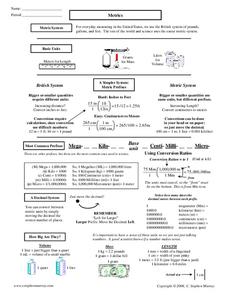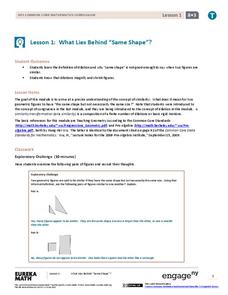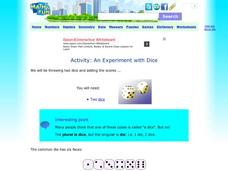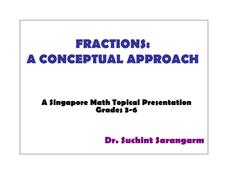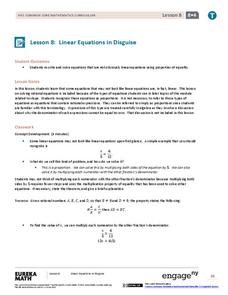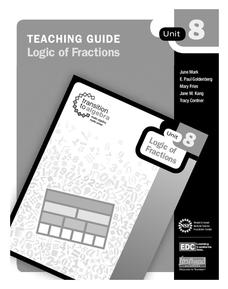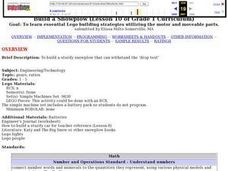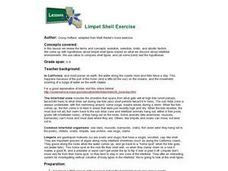Curated OER
Density
Students explore and analyze the relationship between density, mass, volume and ratios. They complete a lab to define mass and volume and then show the density that equals a mass and volume formula. Their lab involves a suitcase,...
Curated OER
Metrics
In this metrics activity, students read information about the metric system. Students review the concepts of prefixes, conversion ratios, and the decimal system. This activity has 17 matching, 31 fill in the blank, and 8 word problems.
Curated OER
Factoring With Polynomials
In this algebra worksheet, students factor polynomials using the greatest common factor. They also use the foil method. There are 8 questions with an answer key.
Curated OER
Roofing and Right Triangles
Young scholars use models and symbols to represent properties of the Pythagorean Theorem. In this right triangle instructional activity, students connect real jobs to properties of right triangles. They solve word problems applying the...
Science Friday
Make a Model of a Home Made From Shipping Containers
Build a scale model of a home built out of shipping containers. A hands-on activity has scholars watch a video about a home built from shipping containers and then design their own home. They build scale models of their designed homes...
Illustrative Mathematics
Floor Plan
A multi-step problem has learners finding the actual area based on a scale drawing and then converting units at the end. Two different solution choices are listed depending on the preference on which step to start first. Both methods can...
EngageNY
Unknown Angles
How do you solve an equation like trigonometry? Learners apply their understanding of trigonometric ratios to find unknown angles in right triangles. They learn the meaning of arcsine, arccosine, and arctangent. Problems include...
EngageNY
Population Problems
Find the percent of the population that meets the criteria. The 17th segment of a 20-part unit presents problems that involve percents of a population. Pupils use tape diagrams to create equations to find the percents of subgroups...
Project Maths
Introduction to Trigonometry
The topic of trigonometric ratios is often covered with loads of rote memorization baked into the activity. This activity set, however, leans more on using similar triangles and discovery learning to help young geometers develop a deeper...
EngageNY
What Lies Behind “Same Shape”?
Develop a more precise definition of similar. The lesson begins with an informal definition of similar figures and develops the need to be more precise. The class learns about dilations and uses that knowledge to arrive at a...
EngageNY
Word Problems Leading to Rational Equations
Show learners how to apply rational equations to the real world. Learners solve problems such as those involving averages and dilution. They write equations to model the situation and then solve them to answer the question —...
Curated OER
Activity: An Experiment with Dice
Roll the dice with this activity and teach young mathematicians about probability. Record outcomes for rolling two number cubes in order to determine what is most likely to happen. Graph the data and investigate patterns in the results,...
Curated OER
Fractions: A Conceptual Approach
If you are teaching fractions to elementary learners this year, this Singapore Math presentation is essential to your curriculum. It addresses several basic fractions concepts in conceptual terms and figures, making each idea accessible...
Virginia Department of Education
Average Atomic Masses
Facilitate learning by using small objects to teach the principles of atomic mass in your science class. Pupils determine the average mass of varying beans as they perform a series of competitive experiments. They gather data and...
EngageNY
Linear Equations in Disguise
In the eighth segment of a 33-part unit, learners look at equations that do not appear to be linear at first glance. The equations are proportions where the numerators and denominators may have more than one term. To round out the...
EngageNY
Comparing Estimated Probabilities to Probabilities Predicted by a Model
Small groups devise a plan to find the bag that contains the larger percentage of blue chips. they then institute their plans and compare results to the actual quantities in the bags.
NOAA
Waves
Is it possible to outrun a tsunami? After watching a presentation that explains how waves and tsunamis occur, class members investigate the speed of tsunamis triggered by an earthquake.
Bowland
Alien Invasion
Win the war of the worlds! Scholars solve a variety of problems related to an alien invasion. They determine where spaceships have landed on a coordinate map, devise a plan to avoid the aliens, observe the aliens, and break a code to...
Education Development Center
Logic of Fractions
Before diving into operations with fractions, learners discover the foundation of fractions and how they interact with one another. Exactly as the title says, logic of fractions is the main goal of a resource that shows pupils how...
Curated OER
Build a Snowplow
Pupils design and build a snowplow using LEGO materials. They compete in an Engineer's Challenge to clear a path through Styrofoam peanuts.
Curated OER
Patterns Across Cultures: The Fibonacci Sequence in Visual Art
Learners study the origin of the Fibonacci Sequence. In this investigative lesson students identify works of art where Golden Spiral or Ratio appear.
Curated OER
Solving Algebraic Equations
For this algebraic equations worksheet, 6th graders solve and complete 9 different word problems that include various types of equations. First, they find consecutive even numbers and write an equation to solve. Then, students write a...
Curated OER
Take A Chance Or Two
A two-part instructional activity immerses young statisticians in the concept of probability. On the first day, will conduct experiments with a two-colored coin and learn how to write probabilities as fractions, ratios, and percentages....
Curated OER
Limpet Shell Exercise
Learners review the terms and concepts: evolution, selection, biotic, and abiotic factors. They come up with hypotheses about limpet shell types based on what we discuss about intertidal environments. Students use ratios to compare...

